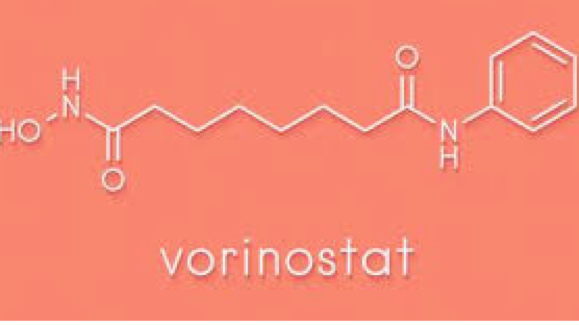Inherited ciHHV-6 has been shown to activate under conditions of immunosuppression and and the pan-HDAC inhibitor TSA activates integrated ciHHV-6 in vitro. This is the first case report of HHV-6 activation in a ciHHV-6 patient who received a pan-HDAC inhibitor drug.
Alert physicians at Beth Israel Deaconness Medical Center in Boston noticed that a 54 year old patient with acute myeloid leukemia developed an extremely high viral load of HHV-6, accompanied by a high grade fever and maculopapular rash, after receiving vorinostat. Foscarnet was administered and the rash rapidly resolved.
Given an extremely high viral load, the patient was tested for chromosomally integrated HHV-6 (ciHHV-6) and was found to be positive. The authors conclude that the patient likely had activated HHV-6, triggered by vorinostat, a pan-HDAC inhibitor. Although it was not possible to measure HHV-6 RNA in this patient to confirm active replication, the ratio of HHV-6 genomes/cell was much greater than 1 during the period of fever and rash, suggesting an additional source of HHV-6 viral copies.
Chromosomally integrated HHV-6 can activate in vitro in response to stimulation by steroids and the pan-HDAC inhibitor trichostatin A (Arbuckle 2010). ciHHV-6 can also reactivate in vivo in conditions of immunosuppression (Endo 2014), transplantation (Bonnafous 2018) and in pregnant women (Gravel 2013).
Fortunately, this patient received excellent care, including prompt antiviral therapy and diagnosis of her ciHHV-6 condition.
The concern, however is that in many institutions, the HHV-6 viral load would not be monitored, leading to a delay in the administration of antivirals. Vorinostat is sold by Merck under the trade name Zolinza.
Vorinostat was approved in the US in 2006 for cutaneous T cell lymphoma, but Merck withdrew a proposal to market vorinostat in the European Union. Other pan-HDAC inhibitor drugs included belinostat for T cell lymphoma and panabiostat for multiple myeloma.
Read the full paper: Politikos 2018.

